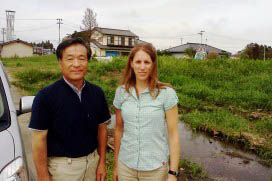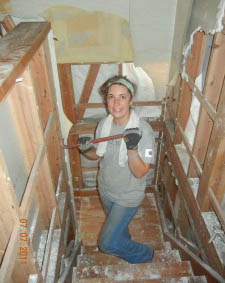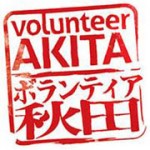
Steven Horowitz, JET alumnus and creator of JETwit
American View: How many Americans are currently participating in the Japan Exchange and Teaching (JET) program? How many American alumni are there?
Steven Horowitz: Based on the JET Programme website, there were 4,330 JETs in total as of July 2011, 2322 of whom were Americans. Over 55,000 people from 50 different countries have participated in the JET Programme since its inception.
American View: What is your role in JET activities to assist with Japan’s recovery following the March 11 disaster?
Steven Horowitz: As the publisher of the JETwit.com site, which is the official unofficial online resource for the JET alumni community, I found myself playing an information gathering and sharing role. JETwit is the main information source for the JET alumni community in the U.S. and internationally. So I started obsessively gathering information from different news sources, following and posting on Facebook groups, and tracking down other sources and trying to piece information together in a way that would be helpful to JET alumni and relatives of JETs in the U.S. and elsewhere.

JET alumna Amy Cameron returns to Fukushima on the Tohoku Invitational Program and is reunited with her former supervisor Mr. Tanji (Photo courtesy of JETwit)
I then gradually shifted my role to using JETwit and my network to help to share information and connect people with regard to fundraising and activating the JET alumni community as well as letting people know the wonderful and varied ways in which individual JETs and JET alumni as well as JET Alumni Association chapters have been supporting recovery efforts since 3/11.
In general, I guess I’ve done a lot of working behind the scenes to help connect people and share information and help put pieces together and lay groundwork, as have many others. I also helped organize and am a member of the JETAA USA Relief Fund Committee, which raised well over $80,000 that has gone towards supporting recovery projects in Ishinomaki (Miyagi Prefecture) and Rikuzentakata (Iwate Prefecture), the two towns where we lost JETs in the tsunami (Taylor Anderson and Monty Dickson).
American View: What types of disaster relief activities have JET alumni been involved in so far?
Steven Horowitz: All JETAA chapters, in the U.S. and around the world, have engaged in fundraising activities. The JETAA chapters in the U.S., which are all independent, organized various fundraisers and other activities aimed at disaster relief. Most of them pooled their funds into a central JETAA USA Fund, while other chapters collaborated with local Japan-related organizations to raise money for other organizations such as the Japan Red Cross. JETAA USA raised over $80,000 which went directly to several education oriented recipients that it identified through its own relationships and contacts.
It is worth noting that many JET alumni in the U.S. and around the world raised funds on their own and sent them directly to Tohoku through a variety of other channels. We recently surveyed chapters worldwide and found that altogether JET alumni groups and current JET participants around the globe have helped raise a total of at least 38 million yen ($485,000) so far for the disaster, and that’s just the amount that we’ve been able to document.
The Japanese government invited Tohoku JET alumni to apply for a program where they would be sent back to the communities in Tohoku where they worked for about 10 days, after which they would write and blog about their experiences to help people understand what’s going on. Twenty JET alumni from the U.S., Canada and elsewhere were selected. Examples of their writing can be found by perusing this JETwit site. Numerous JET alumni have also gone back as part of groups and individually.
Many JET alumni already working for Japan Societies and other non-profits have supported relief efforts. One notable example is Jim Gannon, who is the Executive Director for the Japan Center for International Exchange/USA. His organization has played a very big role not only in raising significant funds, but in helping American organizations and donors understand the situation and context for Japan and make donations in intelligent and informed ways.
Numerous JET alumni translators have also provided help in a variety of ways. In one particular example, we learned that grant writing was a key need in an underdeveloped Japanese non-profit sector and translation of those grants into English was a key step. I put the word out via JETwit and the JET Alum Translators group I set up a while back on LinkedIn, and we were able to very quickly put together an experienced team of translators (all JET alumni) who helped translate grant applications.
American View: Could you provide some specific examples of the relief activities JET participants and alumni have been involved in?
Steven Horowitz: Some JET alumni came quickly back to Japan to volunteer in the disaster zone. For example, three days after the earthquake, Stuart Harris, a doctor who specializes in wilderness medicine, led a team of doctors from Massachusetts General Hospital to Iwate, where he had lived as a JET Program participant. They travelled around the area providing emergency medical care to survivors in the freezing weather.
Current JET participants did similarly impressive things. One group from Akita Prefecture formed an organization they called volunteerAKITA(created by Akita JET Paul Yoo). They spent the first few months after the disaster raising funds to purchase fresh fruit, which they then delivered weekly to evacuation centers in Kesennuma and Ishinomaki. Now, they are carrying out a range of volunteer activities in the disaster zone.
Current JETs also started the “Man Up Campaign.” “Man” is the word in Japanese for 10,000 yen. JETs across the country signed up to have 10,000 yen drawn from their next paycheck for disaster relief. The campaign spread like wildfire on Facebook and elsewhere and quickly raised a lot of money.
Smile Kids Japan was founded by British JET alumnus Mike Maher-King to send JETs to volunteer at local orphanages to spend time with the kids and brighten their daily routine through games and study, like regular schoolchildren have. After the disaster, this group quickly mobilized to deliver relief supplies to the orphanages they work with, which had the added benefit of showing the kids that there are people who care and are thinking of them.

Shimane JET participants climbed Mount Sanbe to raise funds for disaster relief.
While these JETs were on the ground providing direct aid in Tohoku, others began to raise funds for relief and recovery. A group of JET participants in Shimane Prefecture climbed Mt. Sanbe as part of a fundraiser, and they ended up raising 1,200,000 yen. Meanwhile, one JET participant who lives in Yamamoto Town in Miyagi Prefecture launched an appeal on his own to raise funds for schools in his city. By the time he had finished, he had collected 1,600,000 yen for them.
JET alumnus Anthony Bianchi, who is now a city councilman in his JET town of Inuyama City in Aichi Prefecture and maintains strong ties with his alma mater Xavier High School in Brooklyn, helped organize a big disaster relief fundraiser with Xavier and flew back to Brooklyn to attend. JET alumni John Gauntner and Chris Johnson, who have both become established sake experts, have been heavily involved in supporting fundraising efforts organized by sake brewers.
American View: What were some of the problems JET alumni encountered while trying to set up activities to support Japan’s recovery?
Steven Horowitz: I think one of the main challenges has been the relative lack of nonprofit infrastructure and culture in Japan. Organizations and individuals from the U.S. and elsewhere raised significant amounts of money for Japan. However, the challenge has been finding nonprofits to give the money to. Nonprofits have been growing in Japan to meet the challenge, but often they don’t have the experience or sophistication to write grants and do the reporting required of most donors in the U.S. One of the advantages for the JETAA USA Fund has been our extensive network of alumni connected to Japan in a multitude of ways. That enabled us to have conversations that helped us identify needs and organizations in ways that others have struggled with.
American View: How have the Japanese public and Japanese government responded to JET alumni disaster relief activities?
Steven Horowitz: They have been extremely appreciative. I think they have really felt the value of having a quasi-expat population of over 55,000 worldwide. A number of JET alumni met with Mayor Toba of Rikuzentakata City in October in what was described as a very moving session. There has also been considerable media coverage in the Japanese press about the difference that the JET donations are making on the ground.
I (and JETwit) also received a Certificate of Appreciation from the Chairperson of the Council of Local Authorities for International Relations (CLAIR) for “sustained and far-reaching efforts on behalf of the people of Japan” in connection with the informational role I served through JETwit in the days and weeks following the disaster. I believe other JET alumni and chapters received similar types of recognition from CLAIR as well as from the Ministry of Foreign Affairs (MOFA).
American View: How did American JET program participants in the Tohoku area respond to the disaster situation? Did some remain in the area despite the risks?

JET alumna Rachel Vigil-Garcia helps remove drywall panels at a sushi restaurant in Ofunato, Iwate (Photo courtesy of JETwit)
Steven Horowitz: I think there was a great desire to stay among JETs in the region. But the conditions on the ground required many to leave and return home for at least a period of time given that their dwellings and towns were destroyed or severely damaged. There was a notable JET alumna, Canon Purdy, who had gone back to see her students graduate in Minamisanriku even though she’d finished her time on JET the year before. She actually ended up staying there for a while to help with recovery and relief efforts.
American View: Have any special programs been organized in connection with the two American teachers who lost their lives in the March 11 disaster?
Steven Horowitz: The Japan Foundation has set up a program in memory of Taylor Anderson and Montgomery Dickson, JETs who lost their lives in the disaster, to send 32 high school students to Japan for two weeks to experience Japanese culture and study the language. The JETAA USA Taylor Anderson Fund is also supporting a range of innovative programs in Ishinomaki, where Taylor Anderson taught, including exchange programs for local students and “reading corners” at elementary schools. The JETAA USA donation for the tutoring project in Rikuzentakata, where Montgomery Dickson taught, is being credited with a three-fold increase in the number of middle school students taking the English aptitude tests, which is nearly 80% of all students in the town.(See more information here.)
American View: Have any JET program participants published accounts of their experiences in the disaster?
Steven Horowitz: Yes. One JET alum named Brent Stirling was involved in the publication ofQuakebook, a book of stories, art, and photographs that reflect first person accounts of the disaster, with all proceeds going to benefit the Japan Red Cross. Brent contributed his own story and helped with marketing. JET Kathryn Oi, who was living in Minamisanriku at the time, wrote an essay that was published in her college alumni magazine. Additionally, there are numerous JET alumni journalists who have written on the topic. One journalist of note is Fukushima JET alumnus Graham Shelby whose pieces on Japan have appeared on NPR among other outlets. Many JETs have also written blogs about their experiences.
American View: One year has passed since the disasters that hit on March 11, 2011. How much progress has been made in relief efforts by JET program participants and alumni?
Steven Horowitz: The JETAA USA fund and other JETAA chapters raised a lot of money, most of which has been disbursed to nonprofits involved in education. But JETs are committed to continuing to help in whatever way possible. I continue to see postings by JET alums on Facebook groups and elsewhere about various fundraisers that are being organized to help with recovery in Japan.
American View: What is unique about disaster relief activities by JET program participants and alumni?
Steven Horowitz: The connection we have to the affected areas and to each other. And the language skills and ability to communicate directly with people in the communities. When you work for the school system, you really get connected to the community. You understand how things work, how kids evolve into adults. You’re part of the community. As a result, JETs are able to identify needs and then reach out to a global community to help fill them in unique ways. I think JETs and JET alumni in some ways were better able to identify needs on the ground than some of the larger, more removed relief organizations, and especially with regard to education-related needs.
Steven Horowitz is a lawyer by training and works as a grant writer for the Jewish Outreach Institute in New York. After JET, he went to Duke Law School and spent time working for two Japanese law firms and studying at Waseda University before moving to New York to work for a law firm. In 2002 he began serving as the editor of the JETAANY Newsletter (now the JETAANY Magazine) and in 2005 was JETAANY’s representative at the JETAA International Meeting in Japan. He used his role as newsletter editor to reach out to newsletter editors in other chapters, eventually leading him to create the Writers Interpreters Translators (WIT) Group and JETwit.com in 2008 as a resource for the JET alumni community. He currently serves on the JETAA NY Board of Directors as well as the JETAA USA Fund Committee. His goal is to help JET alumni connect with each other and find and create work opportunities for themselves and each other.









COMMENTS0
LEAVE A COMMENT
TOP